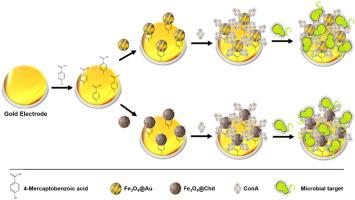Microbiological Research ( IF 6.7 ) Pub Date : 2021-07-31 , DOI: 10.1016/j.micres.2021.126834 Alberto G da Silva Junior 1 , Isaac A M Frias 1 , Reginaldo G Lima-Neto 2 , Sandra R Sá 3 , Maria D L Oliveira 1 , César A S Andrade 1

|
Biosensors are pre-prepared diagnostic devices composed of at least one biological probe. These devices are envisaged for the practical identification of specific targets of microbiological interest. In recent years, the use of narrow-specific probes such as lectins has been proven to distinguish bacteria and glycoproteins based on their superficial glycomic pattern. For instance, Concanavalin A is a carbohydrate-binding lectin indicated as a narrow-specific biological probe for Gram-negative bacteria. As a drawback, Gram-positive bacteria are frequently overlooked from lectin-based biosensing studies because their identification results in low resolution and overlapped signals. In this work, the authors explore the effect that platform nanostructuration has over the electrochemical response of ConA-based platforms constructed for bacterial detection; one is formed of chitosan-capped magnetic nanoparticles, and another is composed of gold nanoparticle-decorated magnetic nanoparticles. The biosensing platforms were characterized by electrochemical impedance spectroscopy (EIS) and cyclic voltammetry (CV) as a function of bacterial concentration. Our results show that probe-target interaction causes variations in the electrical responses of nanostructured transducers. Moreover, the association of gold nanoparticles to magnetic nanoparticles resulted in an electrical enhancement capable of overcoming low resolution and overlapping Gram-positive identification. Both platforms attained a limit of detection of 10 ° CFU mL−1, which is useful for water analyses and sanitation concerns, where low CFU mL−1 are always expected. Although both platforms were able to detect Gram-negative bacteria, Gram-positives were only correctly differentiated by the gold nanoparticle-decorated magnetic nanoparticles, thus demonstrating the positive influence of hierarchically nanostructured platforms.
中文翻译:

Concanavalin A 通过分级纳米结构传感器区分革兰氏阳性菌
生物传感器是由至少一个生物探针组成的预先准备好的诊断设备。这些设备旨在实际识别微生物感兴趣的特定目标。近年来,已证明使用凝集素等窄特异性探针可根据表面糖组模式区分细菌和糖蛋白。例如,伴刀豆球蛋白 A 是一种碳水化合物结合凝集素,可用作革兰氏阴性菌的窄特异性生物探针。作为一个缺点,革兰氏阳性细菌经常被基于凝集素的生物传感研究所忽视,因为它们的识别导致低分辨率和重叠信号。在这项工作中,作者探索了平台纳米结构对用于细菌检测的基于 ConA 的平台的电化学响应的影响;一种是由壳聚糖包覆的磁性纳米粒子组成,另一种是由金纳米粒子修饰的磁性纳米粒子组成。生物传感平台的特点是电化学阻抗谱 (EIS) 和循环伏安法 (CV) 作为细菌浓度的函数。我们的结果表明,探针-目标相互作用会导致纳米结构换能器的电响应发生变化。此外,金纳米粒子与磁性纳米粒子的结合导致电增强,能够克服低分辨率和重叠革兰氏阳性鉴定。两个平台均达到 10 ° CFU mL 的检测限 一种是由壳聚糖包覆的磁性纳米粒子组成,另一种是由金纳米粒子修饰的磁性纳米粒子组成。生物传感平台的特点是电化学阻抗谱 (EIS) 和循环伏安法 (CV) 作为细菌浓度的函数。我们的结果表明,探针-目标相互作用会导致纳米结构换能器的电响应发生变化。此外,金纳米粒子与磁性纳米粒子的结合导致电增强,能够克服低分辨率和重叠革兰氏阳性鉴定。两个平台均达到 10 ° CFU mL 的检测限 一种是由壳聚糖包覆的磁性纳米粒子组成,另一种是由金纳米粒子修饰的磁性纳米粒子组成。生物传感平台的特点是电化学阻抗谱 (EIS) 和循环伏安法 (CV) 作为细菌浓度的函数。我们的结果表明,探针-目标相互作用会导致纳米结构换能器的电响应发生变化。此外,金纳米粒子与磁性纳米粒子的结合导致电增强,能够克服低分辨率和重叠革兰氏阳性鉴定。两个平台均达到 10 ° CFU mL 的检测限 生物传感平台的特点是电化学阻抗谱 (EIS) 和循环伏安法 (CV) 作为细菌浓度的函数。我们的结果表明,探针-目标相互作用会导致纳米结构换能器的电响应发生变化。此外,金纳米粒子与磁性纳米粒子的结合导致电增强,能够克服低分辨率和重叠革兰氏阳性鉴定。两个平台均达到 10 ° CFU mL 的检测限 生物传感平台的特点是电化学阻抗谱 (EIS) 和循环伏安法 (CV) 作为细菌浓度的函数。我们的结果表明,探针-目标相互作用会导致纳米结构换能器的电响应发生变化。此外,金纳米粒子与磁性纳米粒子的结合导致电增强,能够克服低分辨率和重叠革兰氏阳性鉴定。两个平台均达到 10 ° CFU mL 的检测限 金纳米颗粒与磁性纳米颗粒的结合导致电增强,能够克服低分辨率和重叠革兰氏阳性鉴定。两个平台均达到 10 ° CFU mL 的检测限 金纳米颗粒与磁性纳米颗粒的结合导致电增强,能够克服低分辨率和重叠革兰氏阳性鉴定。两个平台均达到 10 ° CFU mL 的检测限-1,这对于水分析和卫生问题很有用,其中总是预期低 CFU mL -1。尽管这两个平台都能够检测革兰氏阴性菌,但只有金纳米粒子修饰的磁性纳米粒子才能正确区分革兰氏阳性菌,从而证明了分层纳米结构平台的积极影响。



























 京公网安备 11010802027423号
京公网安备 11010802027423号